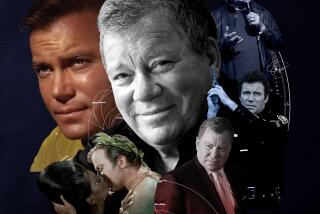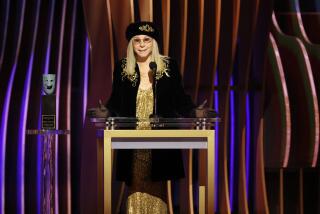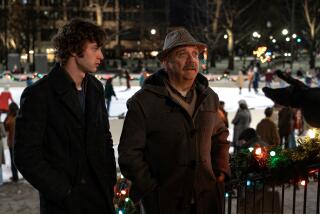Flash points where player meets part
- Share via
DAVID STRATHAIRN
“Good Night, and Good Luck”
*
IT was the kind of get-together that was as stirring as it was scary.
When David Strathairn pulled up his chair for the first group reading of “Good Night, and Good Luck,” he was seated next to more than the film’s cast, producer and director. The room also was filled with friends and relatives of the late Edward R. Murrow, the legendary television newsman Strathairn was about to play in the movie.
Among those invited to the “Good Night, and Good Luck” read-through were Milo Radulovich, the government meteorologist whose impugned patriotism was famously restored by a 1953 Murrow broadcast. Joe and Shirley Wershba, who worked with Murrow on the TV newsmagazine “See It Now,” had places at the table too, as did Murrow’s son, and a widow and two sons of Murrow’s longtime producer, Fred Friendly.
“The feeling in the room, at least for me, was remarkable, so moving,” Strathairn says. “I mean, here are the people who made this story happen.”
And, it must be said, the people who would know if anything in the movie -- or in Strathairn’s depiction of Murrow -- was amiss. Strathairn admits he was terrified of how his portrayal might be received. As it turned out, he needn’t have worried.
For weeks leading up to that day, the 57-year-old actor had been busily reading Murrow biographies and visiting New York’s Museum of Television & Radio, watching Murrow broadcasts, noting his every small gesture, vocal inflection, look.
“They were overwhelming to begin with,” Strathairn says of the old Murrow shows. “I was thinking, ‘How can I climb this mountain?’ But the more I [watched] them over and over, the more they became sort of the be-all and end-all of my characterization. Because his presence on camera was so particular: the sound of his voice, the fact that he read all of his copy, and would look up at the camera to engage it.
“I just glued onto the footage and tried to find the man that way. Not just in his physical presence, but the way he would read, and reference to the camera what he had just read.”
If Strathairn had ample visual evidence on which to base his physical performance of the public Murrow, how did he create the private person, the Murrow not recorded by the television cameras? Strathairn says he let Murrow’s gestures guide his thinking.
“People talk of him and wrote of him as still,” says Strathairn, whose credits include a number of John Sayles movies, including “Eight Men Out,” “Passion Fish” and “Return of the Secaucus 7.” “Obviously, a lot was going on, but he was not a demonstrative guy, and he picked his words carefully. And so I felt that if I derailed the audience’s appreciation of the scene and of the story and of the man with any kind of interpretive stuff, I would be failing. So I stayed with the man in the footage as much as possible, to how he would hold his cigarette, how he was a very still person.”
Fittingly, Strathairn says his favorite scene in “Good Night, and Good Luck” is not when he replicates a Murrow broadcast beat for beat. Rather, it is one in which Murrow doesn’t even speak.
Murrow has just been informed of the suicide of a colleague caught between the Red Scare and Murrow’s own indifference. As soon as he hears of the death, Murrow wordlessly wanders into a CBS control booth to watch a jazz singer (portrayed by Dianne Reeves) sing “How High the Moon.”
“The whole relationship between the two men is encapsulated in that moment,” Strathairn says. “I didn’t really know what I was going to do [when the scene began]. But I think what happened in that scene felt pretty good.”
-- John Horn



